Tideway Central – Marine Works (2020)
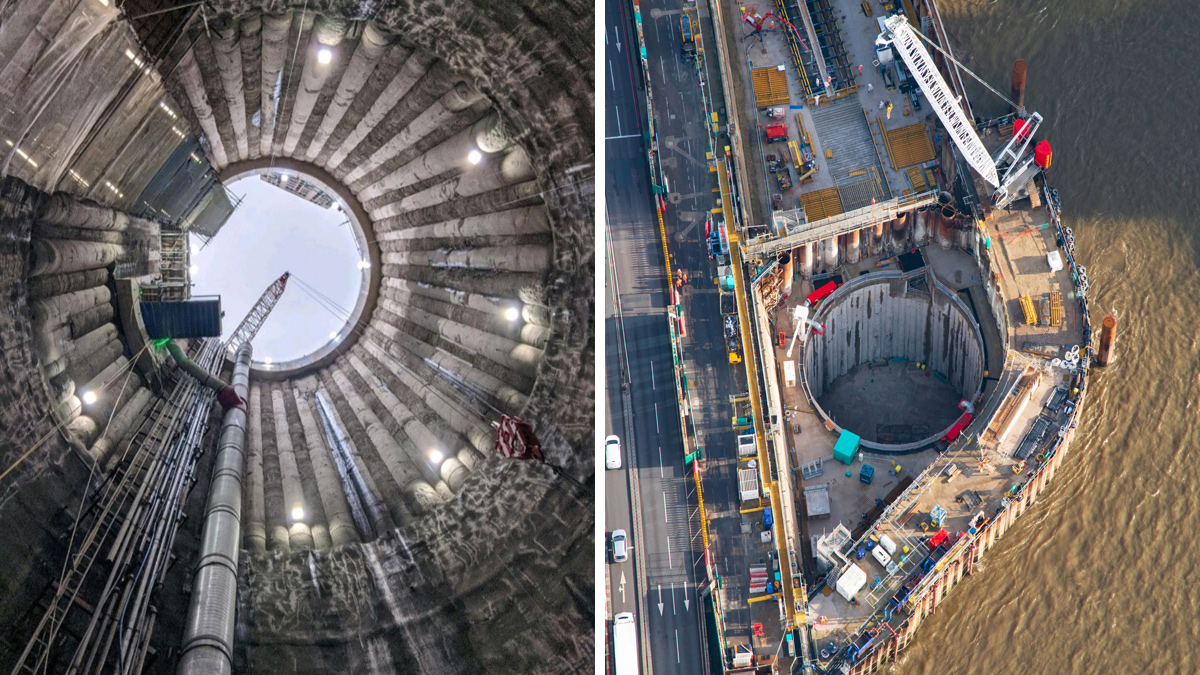
(left) Albert Embankment Foreshore shaft excavation and (right) Blackfriars Bridge Foreshore twin wall cofferdam - Courtesy of FLO JV
The Thames Tideway Tunnel is a new super sewer that will intercept, store and convey the CSO discharges to Beckton STW for treatment. The project is divided into three main work contracts: West, Central and East. The Ferrovial Construction and Laing O’Rourke joint venture (FLO JV) has been appointed as principal contractor for the Central Section with an original estimated budget of £745m. The scope of the works of the Central Section includes the construction of a 12.7km new sewer tunnel under the River Thames between Fulham and Bermondsey. Eight CSO’s spread along the river will be connected through culverts to a new interception chamber and then to a 60m deep shaft structure. From the shaft, the flows will be conveyed into the main tunnel which is being excavated with two 8.8m diameter tunnel boring machines.
Background
London sewerage system dates from the 19th century, developed by Joseph Bazalgette to serve a population of 4 million, with an original capacity of 6mm rainfall per hour across the catchment. Nowadays, over 8 million Londoners have overwhelmed the system’s capacity, making the excess of mixed water to be discharged into the Thames river through different combined sewer overflows (CSOs). In addition, London’s population is expected to reach 10 million within the next 10 years, which will increase the discharges frequency and the pollution of the river to critical levels.
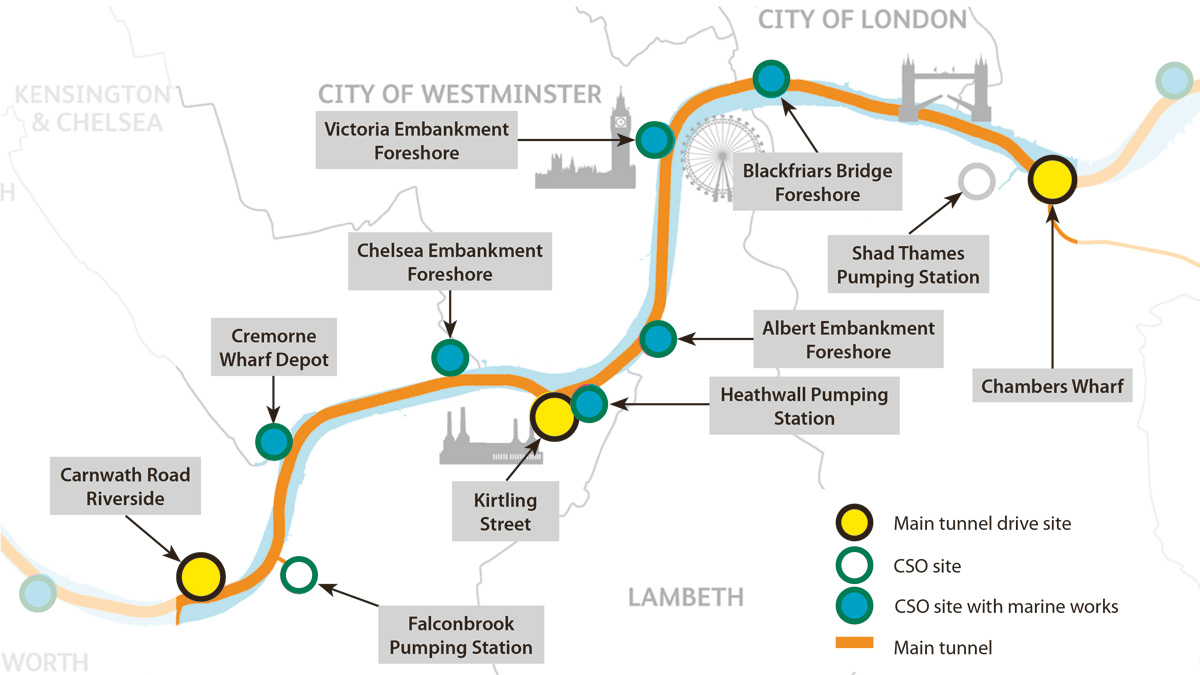
Sites of Tideway Central Section – Courtesy of FLO JV
Central Section: Scope of works
The majority of the permanent structures to be constructed between Fulham and Bermondsey (culverts, interception chambers and shafts) are to be built on new land reclaimed within the Thames by temporary cofferdams that will enable dry construction. The cofferdams are U-shaped structures tying-in against the existing river wall and designed as either double skin or single skin cofferdams. This paper outlines the design and construction methodology of the marine structures, the challenges faced, and the strategies adopted at two high profile sites; Blackfriars Bridge Foreshore and Albert Embankment Foreshore.
Thames Tideway Tunnel – Central Section marine works: Supply chain – key participants
- Client: Bazalgette Tunnel Limited
- Project manager: Tideway (Jacobs)
- Principal designer: Tideway (Jacobs)
- Principal contractor: FLO JV
- Lead designer: FLO JV
- Main designer (permanent works): AECOM
- Sub-consultant (temporary works): Robert West Consulting
- Sub-consultant (temporary works): Beckett Rankine
- Sub-consultant (temporary works): OTB Engineering
- Steel: ArcelorMittal
- Steel: HDM Group
- Tie rods: Anchor Schroeder
- Welding: S&H Welding Services
- Waler beams: PSS
Blackfriars Bridge Foreshore (BLABF)
The BLABF permanent shaft is being constructed 200m upstream of Blackfriars Bridge, close to the Waterloo and City underground line underpass. A culvert will run from the shaft to connect with the Fleet Sewer CSO under the bridge. The temporary cofferdam could not enclose the whole permanent works footprint as its extension is limited by the underground services in the area. A 100m long section of the culvert will be cast in the dry and subsequently towed towards its final position between the CSO opening and the cofferdam.
Due to the challenging programme, the cofferdam is split in two main areas, west and east, which allow the simultaneous construction of different permanent structures.
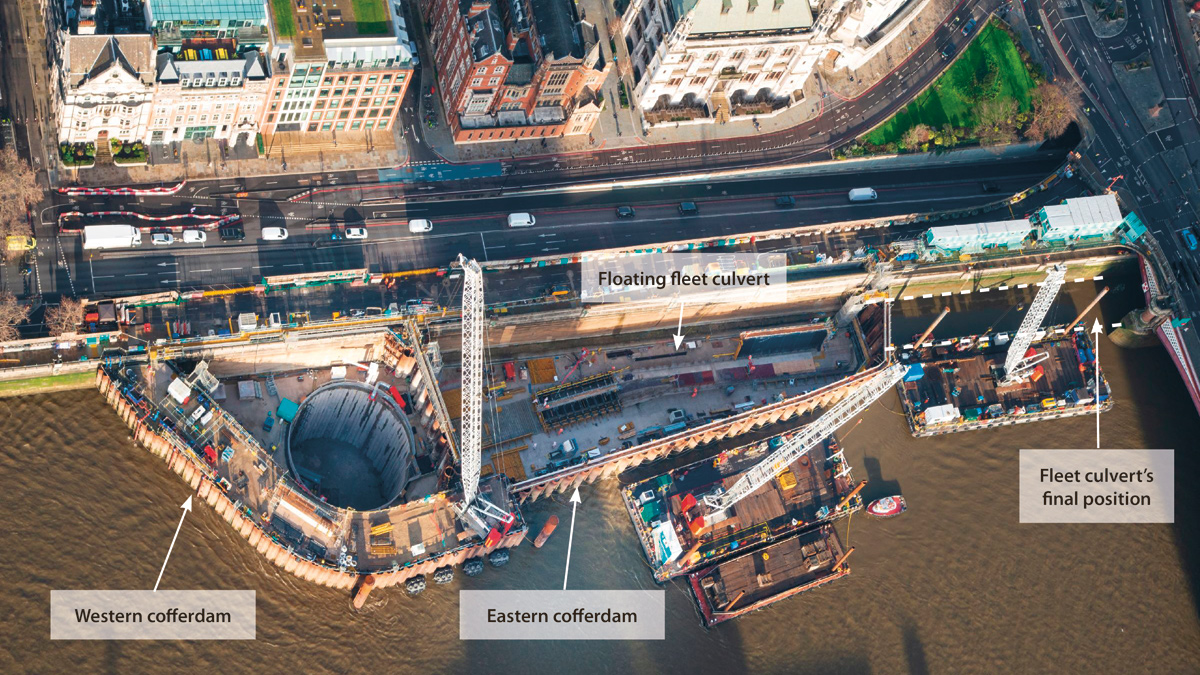
Blackfriars Bridge Foreshore cofferdam – Courtesy of FLO JV
The west area of 1400m2 consists of a twin wall cofferdam of 10m width and 12m height over the riverbed. The walls are high-modulus wall type which combines HZ1800 piles of 25m length with AZ14-700 sheet piles. The 50m deep shaft is excavated from piling platform level which is also 9m below high tide; only 2m separate the shaft excavation from the cofferdam’s internal wall. Before the installation of the shaft piles and therefore its excavation, deep jet-grouting was completed to enable a safe stop and maintenance operations of the TBM at the location of the cofferdam. To date (July 2020) this jet grouting is the deepest undertaken in UK.
The eastern reclaimed area doubles the size of the western section. It is delimited by two cantilever walls 12m over the riverbed; one parallel to the riverbank and the other perpendicular to the previous one. Both walls alternate composite piles (reinforced concrete and steel tubular pile) of 30m length with AZ36 sheet piles. The reclaimed area will be used as a dry dock to cast the 100m concrete culvert that will be floated out to connect with the Fleet Sewer CSO.
Both areas have been built using jack up and flap top barges as working platforms and storage areas. The materials have been transported by the river achieving a great reduction in the CO2 emissions and avoiding the congestion of the capital’s highways. The western cofferdam was the first to be completed; after 9 months of construction. King piles and sheet piles were driven the first 5m using a PVE 24VM vibro-hammer and subsequently a C110X impact hammer till the design toe level, 11m below the riverbed.
Albert Embankment Foreshore (ALBEF)
The ALBEF site is also located in central London close to Vauxhall rail station. Three cofferdams are required as the permanent shaft is around 200m from the Brixton and Clapham CSOs which are also separated by Albert Bridge.
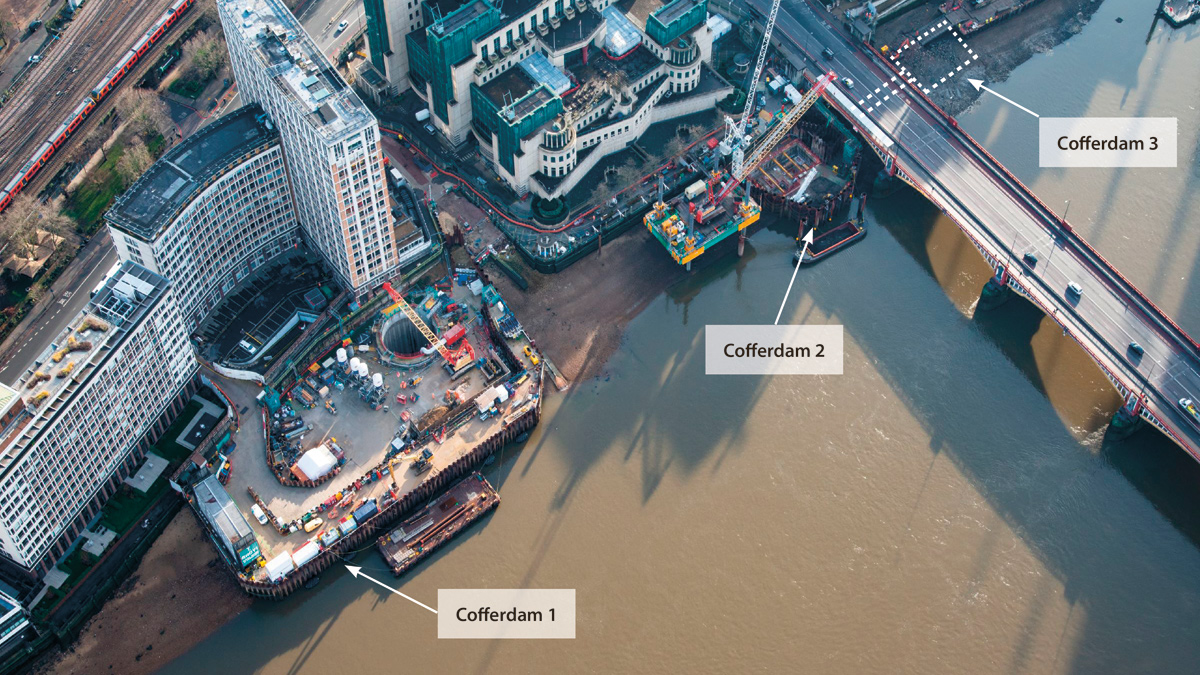
Albert Embankment Foreshore cofferdam – Courtesy of FLO JV
Cofferdam 1 is located in the South Bank of River Thames in front of Camelford House, a 16 storey building. It is a twin wall structure enclosing an area of 3,415m2 where the permanent shaft will be excavated 50m deep. A FEM model has been developed to understand the interaction between the temporary structure, the building foundation and the shaft excavation, demonstrating that excavating the shaft with the proposed methodology was safe and did not impose any detrimental effect on the adjacent building.
Cofferdam 2, also in the South Bank in front of MI6 building, encloses an area of 1,040m2. It consists of a combi-wall structure of steel tubular piles embedded 10m in the London Clay. The permanent interception chamber will be excavated 16m down from the piling platform level (6m below high tide), with less than 2m between the piles of the cofferdam and the chamber wall. The cofferdam has been designed to support the tide loads and the excavation of the chamber.
Downstream of Albert Bridge, next to the Victoria Underground line, Cofferdam 3 is a square area, isolated from the riverbanks. This cofferdam is constructed so that the Clapham culvert can be connected to the IC located inside the Cofferdam 2.
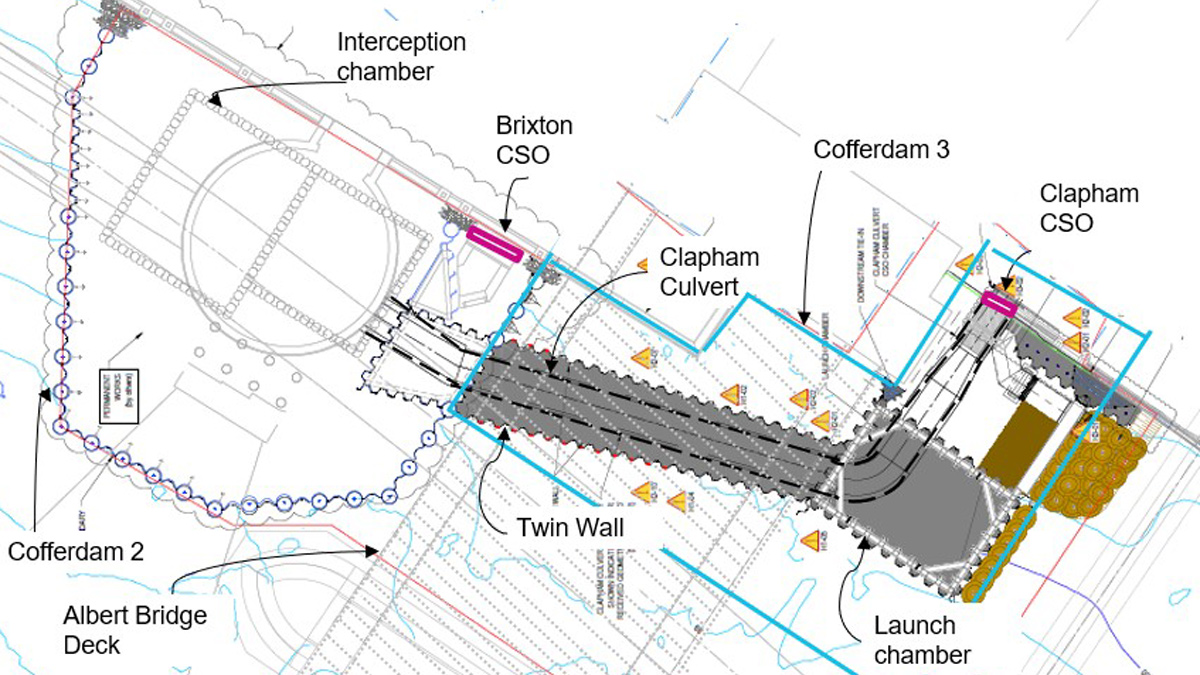
Cofferdam 3 design – Courtesy of FLO JV
Cofferdam 2 and launch chamber are connected under Albert Bridge by a short sheet piled canal called twin wall. Due to the tight headroom of 6.5m, the sheet piles were driven using a Caterpillar 336FL 40Tonne excavator with a Movax vibratory hammer attached. The remaining cofferdam piles were driven using a Giken supercrush silent piler, a non-percussive method.
The new Clapham culvert will be excavated inside the twin wall; constructed with reinforced concrete segments. The culvert is sloped towards the Cofferdam 2, being its shallowest point 1.5m below the riverbed. In order to optimise the construction programme and due to the headroom’s limitations under the bridge the excavation will be done underground. This operation will also be independent from the tide, therefore at high tide there will be 7m of water over the front face of the excavation.
In order to provide a dry environment for the culvert construction, the twin wall area is excavated down to the London Clay. Then the canal is filled with lean concrete which is resistant enough to avoid the collapse of the excavation but also easy to scratch with an excavator. On top of this layer, there is reinforced slab provided with shear connections to the sheet piles which ensures that the area is watertight.
The culvert will be excavated inside the twin wall area using a jack box tunnelling system aided by an excavator at the front face. The jacking legs will be anchored to the launch chamber walls and will transmit up to 1750KN when pressing the tubular concrete segments through the lean concrete/London Clay.
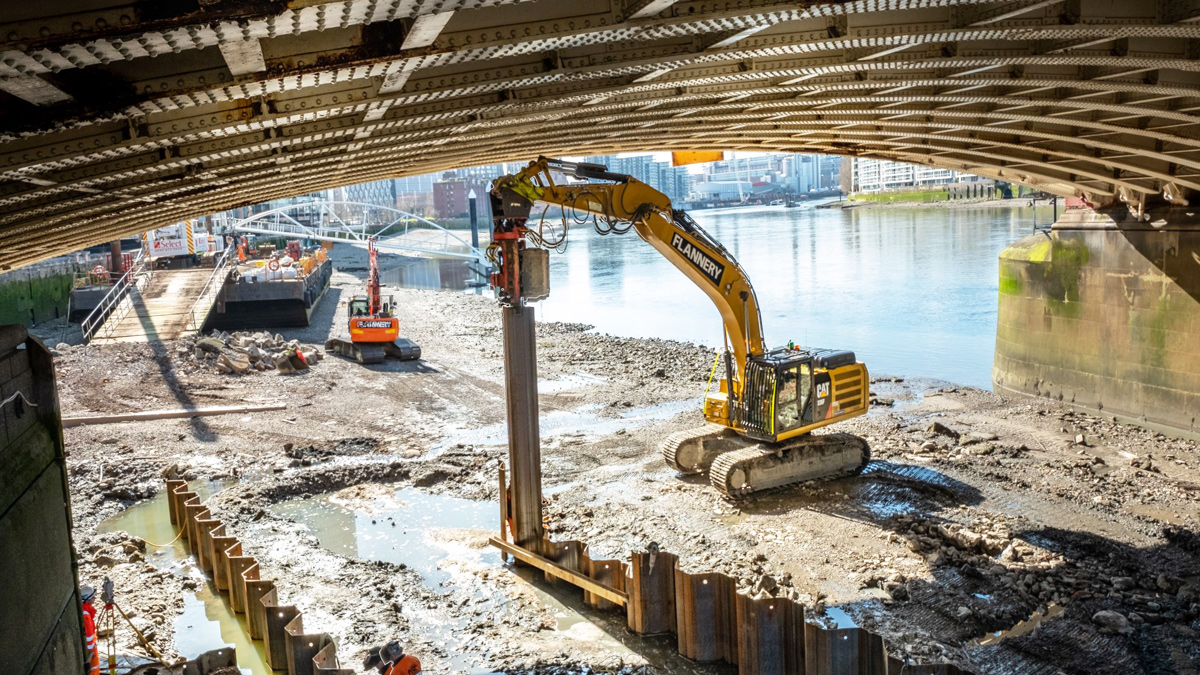
Cofferdam 3 construction: launch chamber sheet piles installation – Courtesy of FLO JV
Technical challenges (ALBEF and BLABF)
Underground assets
Both temporary structures are located in very congested areas; increasing the complexity of the piling works. The three different approaches developed to ensure the protection of the existing structures and underground services such as, exclusion zones, tailored design and driveability assessments are discussed below.
As noted, the London Underground Waterloo and City line crosses beneath the riverbed downstream of the eastern cofferdam at the Blackfriars site. According to LU Design Standards S1050-Civil engineering, no impact drving is allowed within 15m of the tunnel extrados, no piling to be closer than 3m from the lateral or 6m above the tunnel crown. Furthermore, the existing river wall, the Fleet Sewer CSO, and a large gas main also limit the piling works. The characteristics of each structure were analysed and a peak component particle velocity (PPV) threshold was assigned in compliance with BS5228-2, such as 15mm/s for existing river wall; a masonry structure. A safety case was discussed and agreed with London Underground so that all the installation methods were validated by them.
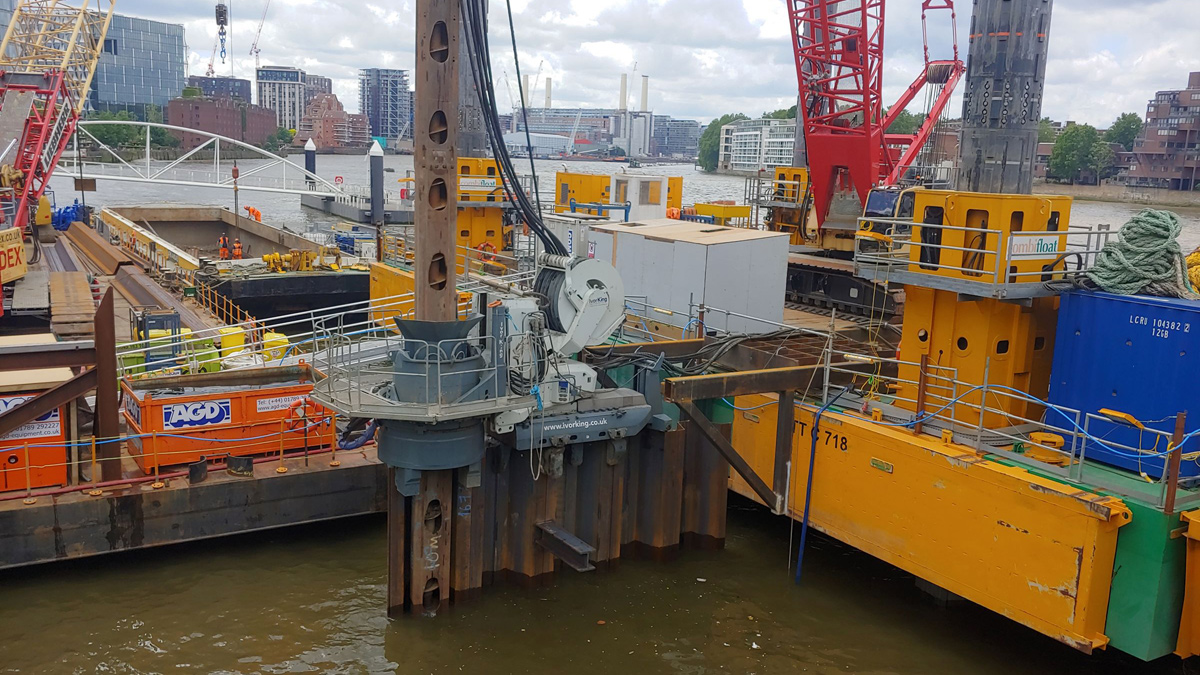
Cofferdam 3 construction: launch chamber walls installation – Courtesy of FLO JV
The conditions explained above, not only limited the extension of the cofferdam to maintain the 15m underground line exclusion zone, but also the design and installation method of the piles. Therefore, a feasibility study was undertaken to assess the viability of different pile sections with enough strength to resist the loads imposed. The results show that the installation of the steel tubular piles to the required depth will exceed the vibration thresholds and a concrete section will increase the complexity of the decommissioning works.
A composite section was selected and built, with the concrete pile top level limited to 1m below the lowest riverbed point and integrated with the permanent scour protection. The steel pile bottom level is set to provide the minimum overlap that guarantees the load transmission between both sections. Different piling equipment (vibro and impact hammers) were assessed through a drivability assessment to ensure that the maximum vibration thresholds were not exceeded. The results conclude that only vibro-driving methods are compatible with the constraints. Three vibro-hammers were analysed, ICE32 NF, ICE 815 C, ICE NF.
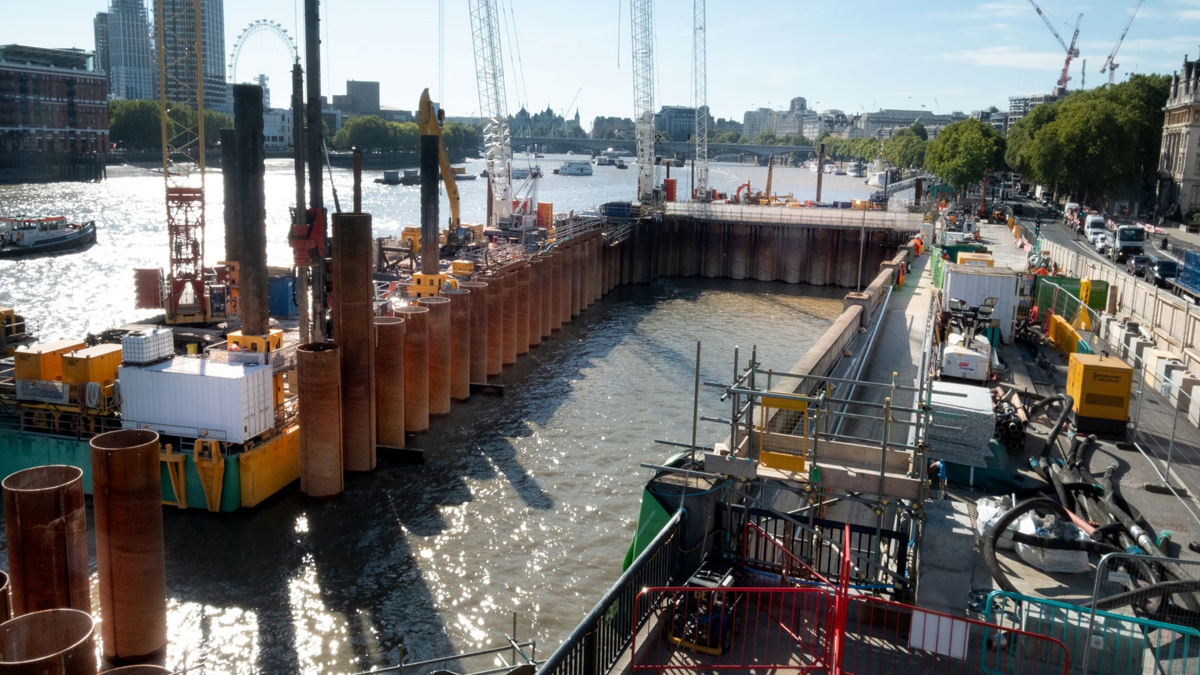
Piling rig boring out concrete section of BLABF piles – Courtesy of FLO JV
Taking everything into account, the construction methodology agreed to install the composite piles was:
- First, steel tubular piles of 1830mm diameter driven 3m in the London Clay using an ICE32NF vibro-hammer.
- Secondly, a piling rig bored out the concrete section 18m in the clay and the rebar cage is lifted in place from jack-up barge.
- Finally, the concrete section is poured using a tremie line.
At ALBEF Cofferdam 3 the construction methods were also adapted to the vibration requirements.
Ship impact strategies
The River Thames basin is a very busy waterway for inland navigation for transporting goods and passengers. Exposing any structure built within the cofferdams is at risk of a ship impact. The Tideway Project has adopted a common strategy to analyse the vessel population to obtain the energy of a potential aberrant ship impact.
In the case of the twin wall cofferdams, which can be considered (more or less) as gravity structures, they have been equipped with a ship impact beam that will spread the load achieving the required energy dissipation. In the case of the cantilever walls, a different approach was undertaken and is discussed below.
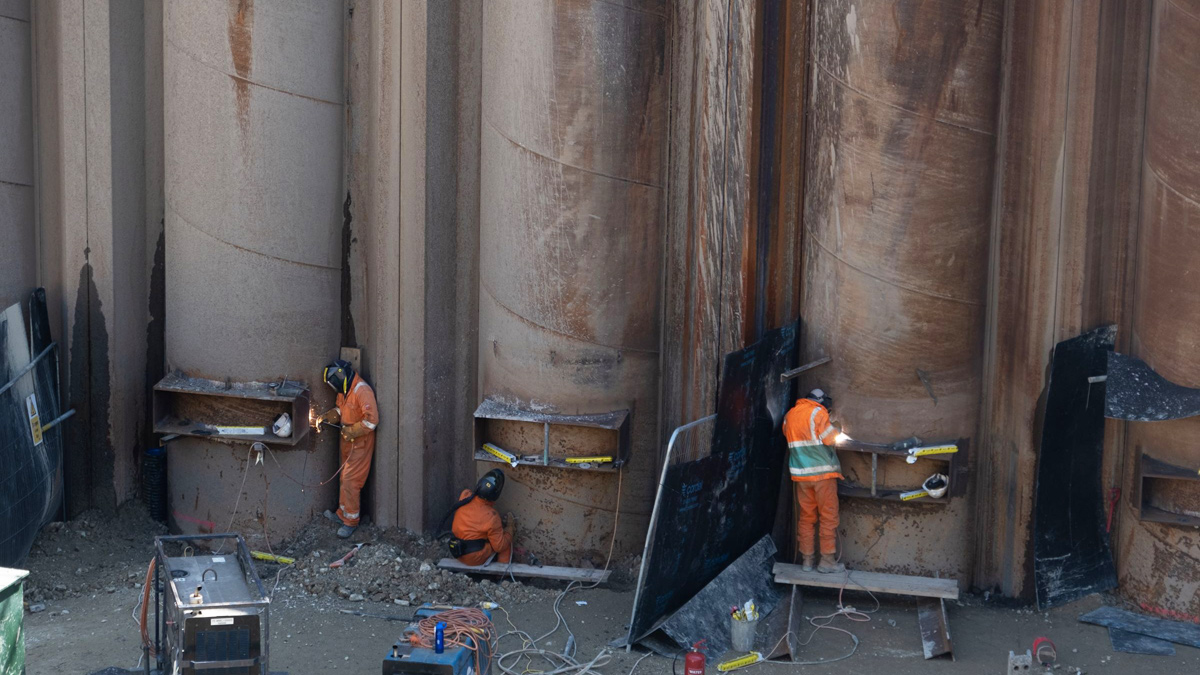
Ship impact beam installation at BLABF combi-wall – Courtesy of FLO JV
The 100m length eastern combi-wall at BLABF is protected by two flap top barges (Willcarry 1500tn and Flap top barge 474) anchored with spud legs. A potential aberrant ship would first impact the barges, dissipating around 40% of its energy during this initial collision. A second impact (with both masses now combined) would occur against the combi-wall which is stiffened using a two HZ1080MA section walers at the top and the hinterland levels. A push over analysis of the structure was carried out in order to obtain the energy absorption which was found to be 3.24MJ for the combi-wall, making the total system able to dissipate up to 4.5MJ. The vessels with a kinetic energy larger than this were included in a risk assessment and decided to be monitored with the help of a guard tug.
The piles at ALBEF Cofferdam 2 are shallower than those at BLABF and since being in another stretch of the river the surrounding conditions are different. The presence of an archaeological exclusion zone along with the limited capacity of the temporary interception chamber, were the main constraints dictating the solution to be put in place.
To overcome these challenges, an innovative design of a ship impact chain net connected to anchors was developed. The chain net is located 8.5m from the outer face of the combi-wall and anchored to the riverbed by 4 (No.) SPEK M anchors with a weight of 10.5 tonnes. It is supported in three piles using weak links, the center pile reducing the catenary length and also used as a mooring point.
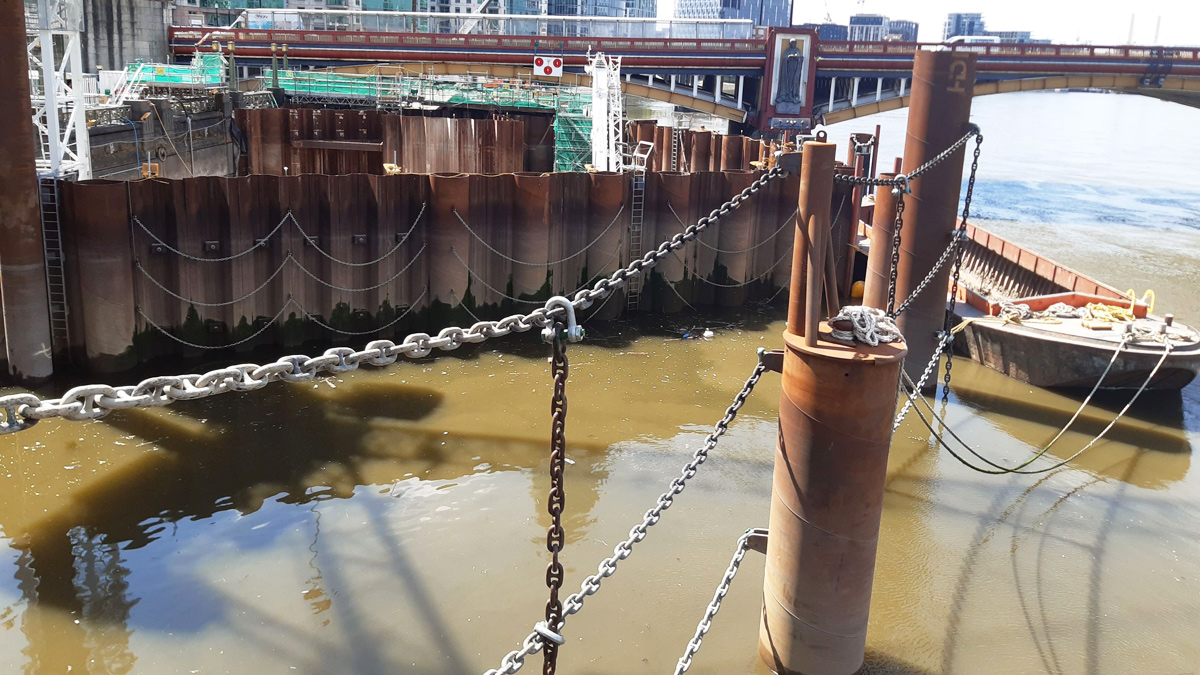
Ship impact chains at ALBEF cofferdam 2 – Courtesy of FLO JV
The net covers 27m across tidal ranges of 7m. It is designed for a 3.50MJ capacity, part of the energy will be dissipated by tensioning the chains catenaries, once the weak links are broken the anchors will be dragged dissipating the rest of the energy. The analysis neglected the friction with the riverbed, the rotation of the ship and the deformation piles in order to achieve a conservative approach to overcome the uncertainties of this complex and innovative design.
Conclusion
To date (July 2020) the project has progressed successfully despite the difficulties faced. 100% of the marine structures and 50% of the permanent structures are currently built. The scheme is expected to be completed by 2024.



